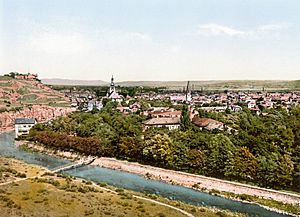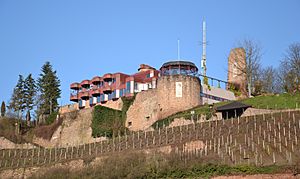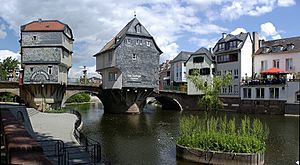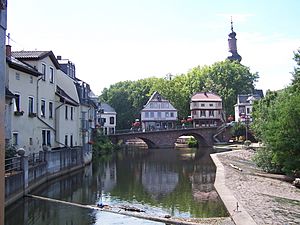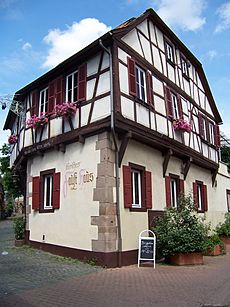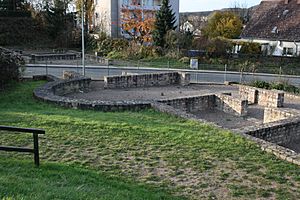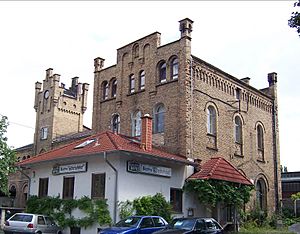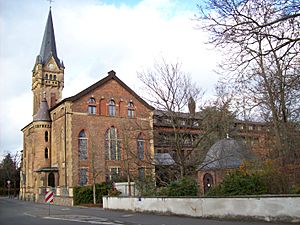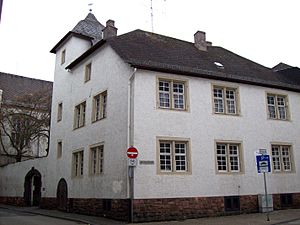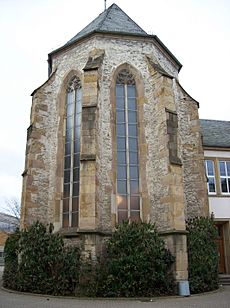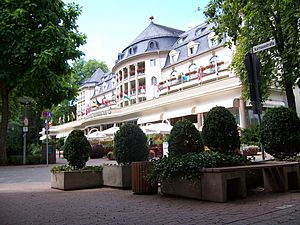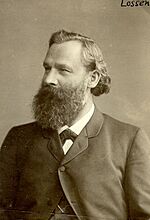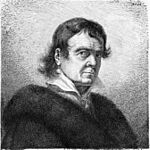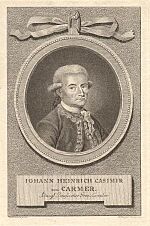Bad Kreuznach facts for kids
Quick facts for kids
Bad Kreuznach
|
||
|---|---|---|
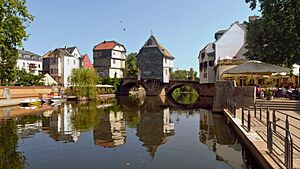 |
||
|
||
| Country | Germany | |
| State | Rhineland-Palatinate | |
| District | Bad Kreuznach | |
| Elevation | 104 m (341 ft) | |
| Population
(2022-12-31)
|
||
| • Total | 52,529 | |
| Time zone | CET/CEST (UTC+1/+2) | |
| Postal codes |
55517-55545
|
|
| Dialling codes | 0671, 06727 | |
| Vehicle registration | KH | |
| Website | www.stadt-bad-kreuznach.de | |
Bad Kreuznach is a town in Germany. It is located in the state of Rhineland-Palatinate. The town is famous for its old medieval bridge, the Alte Nahebrücke. This bridge was built around the year 1300. It is special because it still has buildings on it, which is rare.
Bad Kreuznach is also in the Nahe River wine region. This area is known for its delicious wines. People from all over Germany and the world enjoy wines from grapes like Riesling, Silvaner, and Müller-Thurgau. The town is also a spa town, which means it's a place where people go for health treatments, often using natural spring waters.
Contents
- Geography of Bad Kreuznach
- History of Bad Kreuznach
- Religion in Bad Kreuznach
- Twin Towns – Sister Cities
- Culture and Sightseeing in Bad Kreuznach
- Economy and Infrastructure in Bad Kreuznach
- Notable People from Bad Kreuznach
- Interesting Facts About Bad Kreuznach
- See also
Geography of Bad Kreuznach
Where is Bad Kreuznach located?
Bad Kreuznach is found between three regions: the Hunsrück, Rhenish Hesse, and the North Palatine Uplands. It's about 14 kilometers (9 miles) south-southwest of Bingen am Rhein. The town sits where the Ellerbach stream flows into the Nahe River.
What are Bad Kreuznach's neighborhoods?
Bad Kreuznach has several neighborhoods, also called Ortsbezirke or Stadtteile. These include Bosenheim, Ippesheim, Planig, Winzenheim, and Bad Münster am Stein-Ebernburg.
What is the climate like in Bad Kreuznach?
Bad Kreuznach gets about 517 millimeters (20 inches) of rain each year. This is quite low compared to other places in Germany. January is usually the driest month. June gets the most rain, about 1.8 times more than January. The weather here does not change much throughout the year.
History of Bad Kreuznach
Ancient Times in Bad Kreuznach
People lived in the Bad Kreuznach area as early as the 5th century BC. These were the Celts. Around 58 BC, the Roman Empire took over the area. A Roman settlement, called a vicus, was built here. Legend says it was named after a Celt called Cruciniac. He gave land to the Romans to build a supply station. This station was between Mainz (Mogontiacum) and Trier (Augusta Treverorum).
Bad Kreuznach was on an important Roman road. This road connected Metz (Divodurum) to Bingen am Rhein (Bingium). Around AD 250, a huge and fancy palace was built. It was 81 by 71 meters (266 by 233 feet) and had 50 rooms on the ground floor alone. Pieces of old buildings found nearby suggest there was also a Roman temple. This temple was likely for the god Mercury or both Mercury and Maia. There was also a Gallo-Roman theater.
In 370, Emperor Valentinian I built a military camp (castrum) here. This was to protect the border from Germanic tribes.
Bad Kreuznach in the Middle Ages
|
County of Sponheim-Kreuznach
Grafschaft Sponheim-Kreuznach
|
|||||||||||||
|---|---|---|---|---|---|---|---|---|---|---|---|---|---|
| 1227–1414 | |||||||||||||
| Status | Imperial Village | ||||||||||||
| Capital | Kreuznach | ||||||||||||
| Government | Principality | ||||||||||||
| Historical era | Middle Ages | ||||||||||||
|
• Gottfried III builds Kauzenburg
|
1206–30 | ||||||||||||
|
• Partitioned from Sponheim
|
1227 | ||||||||||||
|
• Comital line extinct; partitioned in three
|
1414 | ||||||||||||
|
|||||||||||||
After the Roman Empire fell, Kreuznach became a royal estate around the year 500. It was part of the growing Frankish Empire. The first church was built inside the old Roman camp walls. It was first named after Saint Martin.
In the early 13th century, the Counts of Sponheim built Kauzenburg castle. This led to the growth of the "New Town" (Neustadt) on the north bank of the Nahe River. Kreuznach was granted town rights, market rights, and other important rights in 1235 and 1270. These rights were confirmed by King Rudolf I in 1290.
A local hero, Michel Mort, is famous from a battle in 1279. He was a butcher from Kreuznach who fought bravely. He sacrificed himself to save Count Johann I of Sponheim.
Records show that Jewish people lived in Kreuznach starting in the late 13th century. In the 13th century, Kreuznach was a strong, fortified town. It survived a siege by Archbishop-Elector Baldwin of Trier in 1320.
In 1417, the Sponheim family line that ruled Kreuznach ended. The county was then divided between Electoral Palatinate and the County of Sponheim-Starkenburg. In 1457, 120 children from Kreuznach left on a children's crusade. They were heading to Mont-Saint-Michel.
The town's salty springs, important for its future as a spa town, were likely found in 1478.
Town Fortifications in the Middle Ages
The town had strong walls, first mentioned in 1247. The Old Town walls formed a square. The New Town also had walls, running from the "Butterchurn" tower to the Nahe River. There were several gates, like the Kilianstor and Löhrpforte. The town also had a defense force, like a local militia.
Jewish Community in Bad Kreuznach
Jewish people were part of Kreuznach's history for centuries. In 1283, Rabbi Ephraim bar Elieser ha-Levi was executed. This was likely connected to accusations against Jews in nearby Mainz.
In 1336, Emperor Louis the Bavarian allowed Count Johann II of Sponheim-Kreuznach to have 60 free Jewish families live on his lands. After the Black Death in 1348/1349, there were no records of Jews until 1375.
The eastern part of today's Poststraße was once called Judengasse ("Jews' Lane"). A "Jewish school" was mentioned in 1482. The oldest Jewish graveyard was near the Rittergut Bangert. A newer Jewish graveyard on Stromberger Straße was bought in 1661. It is one of the best preserved in Rhineland-Palatinate.
Monasteries in Bad Kreuznach
Before the Thirty Years' War, Bad Kreuznach had about 8,000 people and seven monasteries. These included:
- Augustinian convent of Saint Peter.
- Carmelite Monastery to Saint Nicholas, also called the "Black Monastery".
- Saint Wolfgang's Franciscan Monastery.
Plague and Illnesses in Bad Kreuznach
The Plague hit Kreuznach many times. Big outbreaks happened in 1348/1349 (1,600 victims), 1364, 1501/1502, 1608, 1635, and 1666 (1,300 victims). Outside the town, a sickhouse for people with leprosy, called the Gutleuthof, was founded in 1487.
Modern Times in Bad Kreuznach
In the War of the Succession of Landshut, the town and castle were attacked but not captured. In 1507, the famous alchemist Master Faust was the rector of the Latin school. He fled shortly after.
In 1557, the Reformation came to Kreuznach.
Thirty Years' War Impact on Bad Kreuznach
During the Thirty Years' War (1618-1648), Kreuznach was captured many times by different armies.
- On 9 September 1620, Spanish troops took the town.
- On 1 March 1632, Swedish and English troops, led by King Gustav II Adolf, captured Kreuznach.
- In 1635, Imperial troops briefly entered the town.
- On 4 November 1644, French troops under Henri de la Tour d'Auvergne, Vicomte de Turenne took Kreuznach.
The war caused great suffering. The town's population dropped from 8,000 to about 3,500. There was even a saying in German, "He was born at Kreuznach," meaning someone who faced many hardships.
Nine Years' War and Destruction
In the Nine Years' War (1688-1697), Kauzenburg castle was captured in 1688. In May 1689, French troops destroyed the town's defenses and much of Kreuznach. On 18 October 1689, the churches were burned down.
18th Century Changes
By 1708, Kreuznach belonged entirely to Electoral Palatinate. The Karlshalle Saltworks were built in 1729. The Theodorshalle Saltworks were built in 1743. In 1725 and 1784, severe floods caused damage and loss of life.
French Revolutionary and Napoleonic Eras
During the Napoleonic Wars (1792–1814), French troops occupied Kreuznach several times. In 1797, France officially took over the lands on the left bank of the Rhine River, including Kreuznach. This was confirmed by a treaty in 1801.
Napoleon Bonaparte visited Kreuznach in 1804. In 1808, he gave the town's two saltworks to his sister, Pauline. Men from Kreuznach also fought in Napoleon's army during his 1812 Russian Campaign. A monument for them still stands today.
From Vienna Congress to World War I
After Napoleon's defeat, Kreuznach became part of the Kingdom of Prussia in 1815. It was a border town. In 1817, Johann Erhard Prieger opened the first bathing parlor using salty water. This started the town's spa business.
Karl Marx married Jenny von Westphalen in Kreuznach in 1843. The Nahe Valley Railway was built in 1858/1860. This helped the town's industries grow and brought more visitors to the spa.
In 1891, the Franciscan Brothers of the Holy Cross took over a hospital, which became St. Marienwörth. In 1901, the Deaconess's Mother-House moved to Kreuznach.
In 1904, a pharmacist named Karl Aschoff found radon in the Kreuznach brine. Radon is a gas that was believed to have healing properties. A radon inhalatorium was opened in 1912. It used air from an old mine that had high radon levels. This inhalatorium was destroyed in 1945. However, the old mine gallery itself was turned into a therapy room in 1974. Radon inhalation is still used today to help people with rheumatism.
During the First World War, Kaiser Wilhelm II made the Kreuznach spa house his headquarters in 1917. Important meetings took place here.
Weimar Republic and Third Reich
After World War I, French troops occupied Kreuznach. In 1924, Kreuznach was officially given the title Bad, meaning "Bath," because of its health resorts. That's why it's called Bad Kreuznach today.
When Adolf Hitler and the Nazis came to power in 1933, some people, like Hugo Salzmann, resisted them. Jews remaining in the district were deported to Theresienstadt in 1942.
Bad Kreuznach was bombed by Allied forces during Second World War because of its military barracks and important railway line. On 16 March 1945, the town commander surrendered Bad Kreuznach to American troops with little fighting. This saved the town from more destruction.
Bad Kreuznach After 1945
After the war, US troops occupied Bad Kreuznach. Later, it was part of the French zone of occupation. In the 1950s, American forces returned. They had barracks and other facilities until 2001.
In 1958, President of France Charles de Gaulle and Federal Chancellor Konrad Adenauer met in Bad Kreuznach. They agreed to strengthen the relationship between France and Germany. This led to the Élysée Treaty in 1963. A stone monument in front of the old spa house remembers this event.
On 1 April 1960, Bad Kreuznach became a "large town belonging to a district." In 2009, the town was recognized as a "Place of Diversity."
Amalgamations: How Bad Kreuznach Grew
On 7 June 1969, several nearby villages joined Bad Kreuznach. These included Bosenheim, Planig, Ippesheim, and Winzenheim.
Religion in Bad Kreuznach
As of August 2013, Bad Kreuznach had about 44,851 residents. Around 34.4% were Protestant, and 29.8% were Catholic. Many other religious groups also live in the town. About 23.6% of residents did not state a religious affiliation.
Twin Towns – Sister Cities
Bad Kreuznach has two twin towns:
 Bourg-en-Bresse, France (since 1963)
Bourg-en-Bresse, France (since 1963) Neuruppin, Germany (since 1990)
Neuruppin, Germany (since 1990)
Culture and Sightseeing in Bad Kreuznach
Important Buildings and Sites
Many buildings and sites in Bad Kreuznach are listed as cultural monuments. Here are some of the most interesting:
Churches in Bad Kreuznach
- Paul's Protestant Church (Pauluskirche): This church has a Late Gothic part from the 15th century. The main part and tower were built later, in a Classicist style, between 1768 and 1781. Karl Marx was married here in 1843.
- Holy Cross Catholic Parish Church (Pfarrkirche Heilig-Kreuz): This church was built in a Gothic Revival style between 1895 and 1897.
- Saint Nicholas's Catholic Parish Church (Pfarrkirche St. Nikolaus): This church dates back to the 13th and 14th centuries. It was partly changed in the 18th century and renovated between 1897 and 1905.
Castles and Fortifications
- Kauzenburg (castle): Located on the Kauzenberg hill. Parts of the original castle walls and cellars from the 12th century still exist. In 1971, it was turned into a castle inn.
- Town Fortifications: The town once had three sets of walls. These included walls around the "New Town" and "Old Town." Parts of these walls can still be seen today. The Butterfass ("Butterchurn") tower is a preserved part of the New Town wall.
Spa and Historic Areas
- Spa Zone: This area developed after the healing power of the salty water was discovered in 1817. It includes the spa house (1840–1860), bathhouses, and the saltworks (Karlshalle, Theodorshalle).
- New Town (Neustadt): This historic area was founded after 1200. It has late medieval buildings, old noble houses, and timber-frame houses from the 18th century. The Wilhelmsbrücke (bridge) is also here.
- Alte Nahebrücke ("Old Nahe Bridge"): This famous bridge crosses the Nahe River. It was built around 1300 and has houses on it.
- Dr-Faust-Haus (Magister-Faust-Gasse 47): This house is believed to have been the home of Johann Georg Faust, the alchemist. It has timber framing and a cellar from 1590.
- Römerhalle (Dessauer Straße, Hüffelsheimer Straße, Schlosspark Museum-Roman villa): This museum displays two mosaics from an ancient Roman villa built around AD 250. You can also see the tombstone of Tiberius Julius Abdes Pantera here.
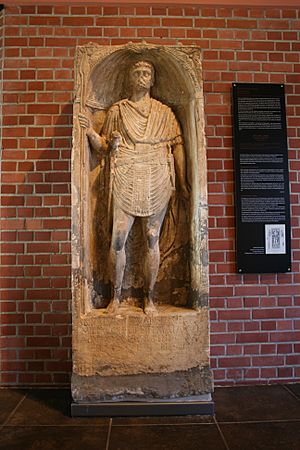
- Spa Park (Kurpark): A beautiful English garden laid out in 1840. It has old buildings, a music pavilion, and sculptures.
Other Notable Buildings
- Former Main Railway Station (Brückes 54): A castle-like building made of red brick, built in 1860.
- Deaconry Institutions (Ringstraße 58): A complex of buildings in a park, started in 1897.
- Wilhelmskirche Tower (Kornmarkt 5): The tower of a former Lutheran church, built after 1862.
- Kronberger Hof (Hospitalgasse 4 and 6): A large, four-wing complex that includes the State Gymnasium. The Kronberger Hof part is a former castle house from around 1600.
- Saltworks (Saline Karlshalle, Saline Theodorshalle): Historic buildings related to salt production, including a graduation tower from the 18th century.
Tourist Attractions in Bad Kreuznach
- The Alte Nahebrücke is a must-see. It's one of the few bridges in the world with houses on it.
- The Kurhaus (built in 1913) is a large hotel and bath house. People visit for health treatments using the natural radon-brine waters.
- The Dr-Faust-Haus is linked to the famous alchemist Johann Georg Faust.
- The Römerhalle museum shows amazing mosaics from an ancient Roman villa.
- Bad Kreuznach is well-known for its wine.
- The town was home to a United States Army base, Rose Barracks, for 50 years. It closed in 2001.
Music and Choirs in Bad Kreuznach
Bad Kreuznach has many music groups and choirs. Some examples are:
- Capella Nicolai
- Chor Cantamus
- Gospelchor Grenzenlos (Borderless Gospel choir)
- Kantorei der Pauluskirche (Paul's Protestant Church choir)
Regular Events in Bad Kreuznach
The town hosts many fun events throughout the year:
- Weekly Market: Held at the Kornmarkt on Tuesdays and Fridays.
- Kreuznacher Jahrmarkt ("Yearly Market"): A big fair held every year in August.
- Fischerstechen ("Water Jousting"): A traditional water jousting event in September.
- Dragon Festival on the Kuhberg: Held in mid to late April.
- French Market: Dealers from Bad Kreuznach's twin town, Bourg-en-Bresse, visit for this special market.
Sports and Leisure in Bad Kreuznach
Sports Clubs in Bad Kreuznach
Bad Kreuznach has many successful sports clubs.
- In trampolining and whitewater slalom, the town is a national leader.
- The VfL 1848 Bad Kreuznach is the biggest club. It had Germany's first basketball department in 1935.
- The Kreuznacher HC is important for field hockey.
- In football, Eintracht Bad Kreuznach is the most successful club. They even played in Germany's highest football league.
- The MTV Bad Kreuznach is one of Germany's top trampolining clubs.
- The RKV Bad Kreuznach is known for canoeing, especially whitewater slalom.
Bad Kreuznach Sport Badge
The town gives out a "Sport Badge" each year. This award honors athletes, teams, and people who support sports. It has three levels:
- Gold: For participating in a world championship or the Olympic Games, or placing 1st to 3rd in a World Cup or European championship.
- Silver: For placing 4th or 5th in a World Cup or European championship, or 1st in a German championship.
- Bronze: For placing 6th or 7th in a World Cup, participating in a European championship, or placing 2nd or 3rd in a German championship.
People who volunteer in sports for at least 25 years can also receive this award.
Economy and Infrastructure in Bad Kreuznach
Winegrowing in Bad Kreuznach
Winegrowing is very important to Bad Kreuznach. The town has 777 hectares (1,920 acres) of vineyards. Most of these grow white wine grapes (77%). This makes it the biggest winegrowing center in the Nahe wine region.
Industry and Trade
Bad Kreuznach has about 1,600 businesses, providing 28,000 jobs. Many people travel from nearby areas to work here. The economy is mostly made up of small and medium-sized businesses. However, there are also larger companies like the tire maker Michelin and the machine builder KHS. The town is also home to Jos. Schneider Optische Werke, which makes famous camera lenses.
Spa and Tourism
Bad Kreuznach is known as the world's oldest radon-brine spa. It is also a major center for treating rheumatism in Rhineland-Palatinate. The town has many beds for guests and receives hundreds of thousands of overnight stays each year.
The spa offers six clinics and thermal brine baths called "Crucenia Thermen." It also has a salt grotto, a radon gallery, and graduation towers in the Salinental. These towers create a salty mist for people to breathe. These treatments help with various health issues, including rheumatic pain, joint problems, and respiratory illnesses.
The town has also developed a large "wellness temple" with 12 saunas. This attracts many visitors each year.
Hospitals and Specialised Clinics
Bad Kreuznach has two general hospitals: the kreuznacher diakonie hospital and the St. Marienwörth hospital. They have modern departments for heart, intestinal, and stroke care.
The town also has specialized clinics in the spa zone. These include the "Sana" Rhineland-Palatinate Rheumatic Centre and the Karl-Aschoff-Klinik. There are also clinics for psychosomatic illnesses and for children and youth.
Transport in Bad Kreuznach
Bad Kreuznach is an important transport hub. Roads and railways follow the narrow Nahe valley.
Rail Transport
From 1896 to 1936, Bad Kreuznach had a narrow-gauge railway network. A steam locomotive from this time can be seen in nearby Bockenau. The town also had a tramway system until 1953.
Today, Bad Kreuznach station is a "wedge station" where railway lines split. Regionalbahn trains run to Kaiserslautern. Regional-Express and Regionalbahn trains connect to Mainz and Saarbrücken.
Road Transport
Bad Kreuznach is connected by the A 61 Autobahn and several main roads (Bundesstraßen 41, 48, and 428). The Autobahn is about 12 kilometers (7.5 miles) from the town center.
The town has a local bus network with frequent services. Many regional bus routes also serve the surrounding area. All bus and train services are part of a regional transport association.
Media in Bad Kreuznach
Broadcast Media
- Antenne Bad Kreuznach is a local radio station.
- domradio Studio-Nahe UKW 87,9 is a local religious radio station.
- Bürgerfernsehen Offener Kanal Bad Kreuznach is a public access television channel.
Print Media
- Allgemeine Zeitung Bad Kreuznach and Oeffentlicher Anzeiger are daily newspapers for the area.
- VorSicht – Das Rhein-Nahe-Journal and Wochenspiegel Bad Kreuznach are weekly publications.
Online Media
- Kreuznach-Blog provides current news and information about Bad Kreuznach online.
- Extrawelle also offers news for the town.
Education and Research in Bad Kreuznach
Bad Kreuznach has many schools, from primary schools to vocational and academic high schools (Gymnasiums).
Primary Schools
- Dr.-Martin-Luther-King-Schule
- Grundschule Kleiststraße
- Grundschule Hofgartenstraße
- Grundschule Planig
- Grundschule Winzenheim
Secondary Schools
- Hauptschule Ringstraße
- Hauptschule am Römerkastell
- Realschule Heidenmauer
- IGS Bad Kreuznach (Comprehensive school)
Gymnasiums (High Schools)
- Lina-Hilger-Gymnasium
- Gymnasium an der Stadtmauer (with classical language and science branches)
- Gymnasium am Römerkastell (with a bilingual branch)
Vocational Schools
- Berufsbildende Schule für Technik, Gewerbe, Hauswirtschaft, Sozialwesen
- Berufsbildende Schule für Wirtschaft
- Berufsbildende Schule Landwirtschaft
Special Schools
- Bethesda-Schule Schule für Körperbehinderte (for physically disabled students)
- Don-Bosco-Schule Schule für geistig Behinderte (for intellectually disabled students)
- Schule am Ellerbach Schule für Lernbehinderte (for students with learning disabilities)
Bad Kreuznach also offers training for future winemakers and agricultural technologists. The Agentur für Qualitätssicherung, Evaluation und Selbstständigkeit von Schulen (Agency for Quality Assurance) and the Pädagogisches Zentrum Rheinland-Pfalz (Paedagogical Centre) are also located here.
Notable People from Bad Kreuznach
Honorary Citizens
Bad Kreuznach has named 12 people as honorary citizens. Three others (Adolf Hitler, Wilhelm Frick, and Richard Walther Darré) had this honor taken away.
- Otto von Bismarck (1895)
- Paul von Hindenburg (1918)
- Erich Ludendorff (1918)
- Werner Forßmann (1957), who won the Nobel Prize in Medicine in 1956.
- Alex Jacob (2008), a hotel owner and honorary consul general for Romania.
People Born in Bad Kreuznach
- Konrad von Kreuznach (died 1368), a poet and musician.
- Conrad Faber von Kreuznach (c. 1500 – c. 1552), a German painter.
- Johann Heinrich von Carmer (1721–1801), a Prussian justice reformer.
- Friedrich Müller (1749–1825), a German poet and painter.
- Carl Löwig (1803–1890), a chemist.
- Eberhard Anheuser (1805–1880), an entrepreneur who owned the Anheuser-Busch brewery.
- Hans Driesch (1867–1941), a biologist and philosopher.
- Karl Sack (1896–1945), a jurist and resistance fighter against the Nazis.
- Hugo Salzmann (1903–1979), a Communist and Antifascist.
- Julia Klöckner (born 1972), a well-known German politician.
- Matthias de Zordo (born 1988), a javelin thrower.
Famous People Connected to Bad Kreuznach
- Friedrich Christian Laukhard (1757–1822), a theologian and writer who spent his last years here.
- Emil Cauer the Elder (1800–1867), a sculptor.
- Werner Forßmann (1904–1979), a cardiologist and Nobel laureate.
- Anna Dogonadze (born 1973), a German-Georgian Olympic champion in trampolining.
- Jean Mannheim (1862–1945), a California Impressionist painter.
- Yann Peifer (born 1974), known as Yanou, a DJ from the group Cascada.
Interesting Facts About Bad Kreuznach
- In the novel Robinson Crusoe (1719) by Daniel Defoe, the main character's family name, Crusoe, is thought to come from "Kreutznaer," meaning "person from Kreuznach."
- Bad Kreuznach is known among photographers as the home of Schneider Optische Werke, a famous company that makes camera lenses.
See also
 In Spanish: Bad Kreuznach para niños
In Spanish: Bad Kreuznach para niños





